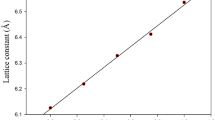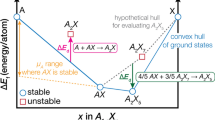Abstract.
We extensively search for the endohedral silicon-fullerene structures of Si31–Si39 using the combination of a tight-binding potential with the density functional theory. The resulting structures of our best candidates characterize more compact features comparing to previous isomers [J. Am. Chem. Soc. 126, 13845 (2004); J. Chem. Phys. 124, 164311 (2006)]. Most of our best candidates belong to new families featuring different core/cage combinations or different original carbon fullerene cages with respect to those of previous isomers. Energy calculations reveal that our best candidates are more stable than the previous best ones at the PW91 level, except for n = 34 and 38. The predicted relative stabilities of these isomers remain even at finite temperatures. In addition, the densities of dangling-bond atoms in the surfaces of our Si33 and Si39 isomers are significantly lower than the previous best candidates, as well as lower than those of their neighbors. This finding together with the densities of the active sites in the surfaces of the previous best candidates of Si34 and Si38 is roughly consistent with the observed relative reactivities of the silicon clusters in the size range of n = 31-39.
Similar content being viewed by others
References
M.F. Jarrold, E.C. Honea, J. Phys. Chem. 95, 9181 (1991)
M.F. Jarrold, J.E. Bower, J. Chem. Phys. 96, 9180 (1992)
M.F. Jarrold, V.A. Constant, Phys. Rev. Lett. 67, 2994 (1991)
R.R. Hudgins, M. Imai, M.F. Jarrold, J. Chem. Phys. 111, 7865 (1999)
K. Fuke, K. Tsukamoto, F. Misaizu, M. Sanekata, J. Chem. Phys. 99, 7807 (1993)
M.F. Jarrold, E.C. Honea, J. Phys. Chem. 95, 9181 (1991)
J.L. Elkind, J.M. Alford, F.D. Weiss, R.T. Laaksonen, R.E. Smalley, J. Chem. Phys. 87, 2397 (1987); S. Maruyama, L.R. Anderson, R.E. Smalley, J. Chem. Phys. 93, 5349 (1990); M. Alford, R.T. Laaksonen, R.E. Smalley, J. Chem. Phys. 94, 2618 (1991); L.R. Anderson, S. Maruyama, R.E. Smalley, Chem. Phys. Lett. 176, 348 (1991)
F.S. Khan, J.Q. Broughton, Phys. Rev. B 43, 11754 (1991)
J. Song, S.E. Ulloa, D.A. Drabold, Phys. Rev. B 53, 8042 (1996)
B.X. Li, P.L. Cao, J. Phys. Cond. Mat. 13, 10865 (2001)
Z.F. Chen, H.J. Jiao, G. Seifert, A.H.C. Horn, D.K. Yu, T. Clark, W. Thiel, P.V.R. Schleyer, J. Comput. Chem. 24, 948 (2003)
E. Kaxiras, Chem. Phys. Lett. 163, 323 (1989); E. Kaxiras, Phys. Rev. Lett. 64, 551 (1990); E. Kaxiras, K. Jackson, Phys. Rev. Lett. 71, 727 (1993)
D.A. Jelski, B.L. Swift, T.T. Rantala, X. Xia, T.F. George, J. Chem. Phys. 95, 8552 (1991)
M.V. Ramakrishna, J. Pan, J. Chem. Phys. 101, 8108 (1994); J. Pan, M.V. Ramakrishna, Phys. Rev. B 50, 15431 (1994)
S. Yoo, J. Zhao, J. Wang, X.C. Zeng, J. Am. Chem. Soc 126, 13845 (2004)
S. Yoo, N. Shao, C. Koehler, T. Fraunhaum, X.C. Zeng, J. Chem. Phys. 124, 164311 (2006)
C.Z. Wang, B.C. Pan, K.M. Ho, J. Phys. Cond. Mat. 11, 2043 (1999)
B. Liu, Z.Y. Lu, B.C. Pan, C.Z. Wang, K.M. Ho, J. Chem. Phys. 109, 9401 (1998)
K.M. Ho, A.A. Shvartsburg, B.C. Pan, Z.Y. Lu, C.Z. Wang, J.G. Wacker, J.L. Fye, M.F. Jarrold, Nature 392, 582 (1998)
R.L. Zhou, B.C. Pan, Phys. Rev. B 73, 045417 (2006)
We compressed each isomer towards the masscenter by scaling all the coordinates with a factor of 0.8. Then the compressed isomers were fully optimized with the treatment of TB potential again. Generaly, compression will change distribution of the distances between atoms. Then force exists on each atom. Under the action of the forces, the compressed isomer may transfer to a more stable isomer.
D. Sánchez-Portal, P. Ordejón, E. Artacho, J.M. Soler, Int. J. Quant. Chem. 65, 453 (1997); N. Troullier, J.L. Martins, Phys. Rev. B 43, 1993 (1991)
J.P. Perdew, K. Burke, M. Ernzerhof, Phys. Rev. Lett. 77, 3865 (1996)
G. Kresse, J. Furthmüller, Phys. Rev. B 54, 11169 (1996); G. Kresse, J. Furthmüller, Comput. Mater. Sci. 6, 15 (1996); J.P. Perdew, in Electronic Structure of Solid 91, edited by P. Ziesche and H. Eschrig (Academie Verlag, Berlin, 1991) p. 11
W. Hellmann, R.G. Hennig, S. Goedecker, C.J. Umrigar, B. Delley, T. Lenosky, Phys. Rev. B 75, 085411 (2007)
Author information
Authors and Affiliations
Corresponding author
Rights and permissions
About this article
Cite this article
Zhou, R., Pan, B. Improved endohedral fullerenelike structures of silicon clusters Si31–Si39 by density functional calculations. Eur. Phys. J. D 47, 367–372 (2008). https://doi.org/10.1140/epjd/e2008-00049-7
Received:
Published:
Issue Date:
DOI: https://doi.org/10.1140/epjd/e2008-00049-7




